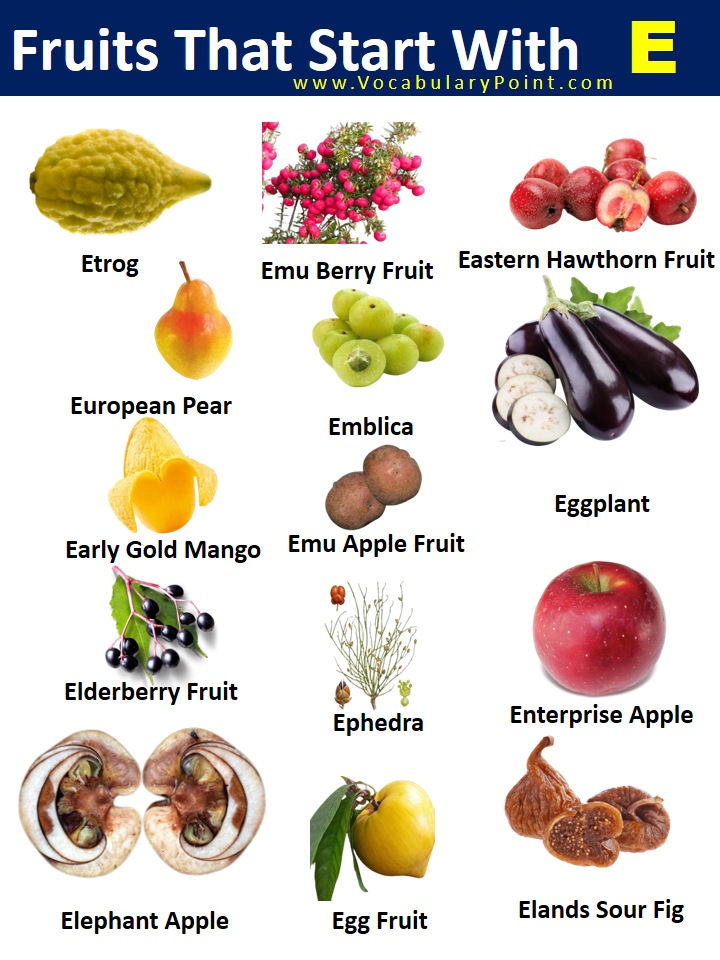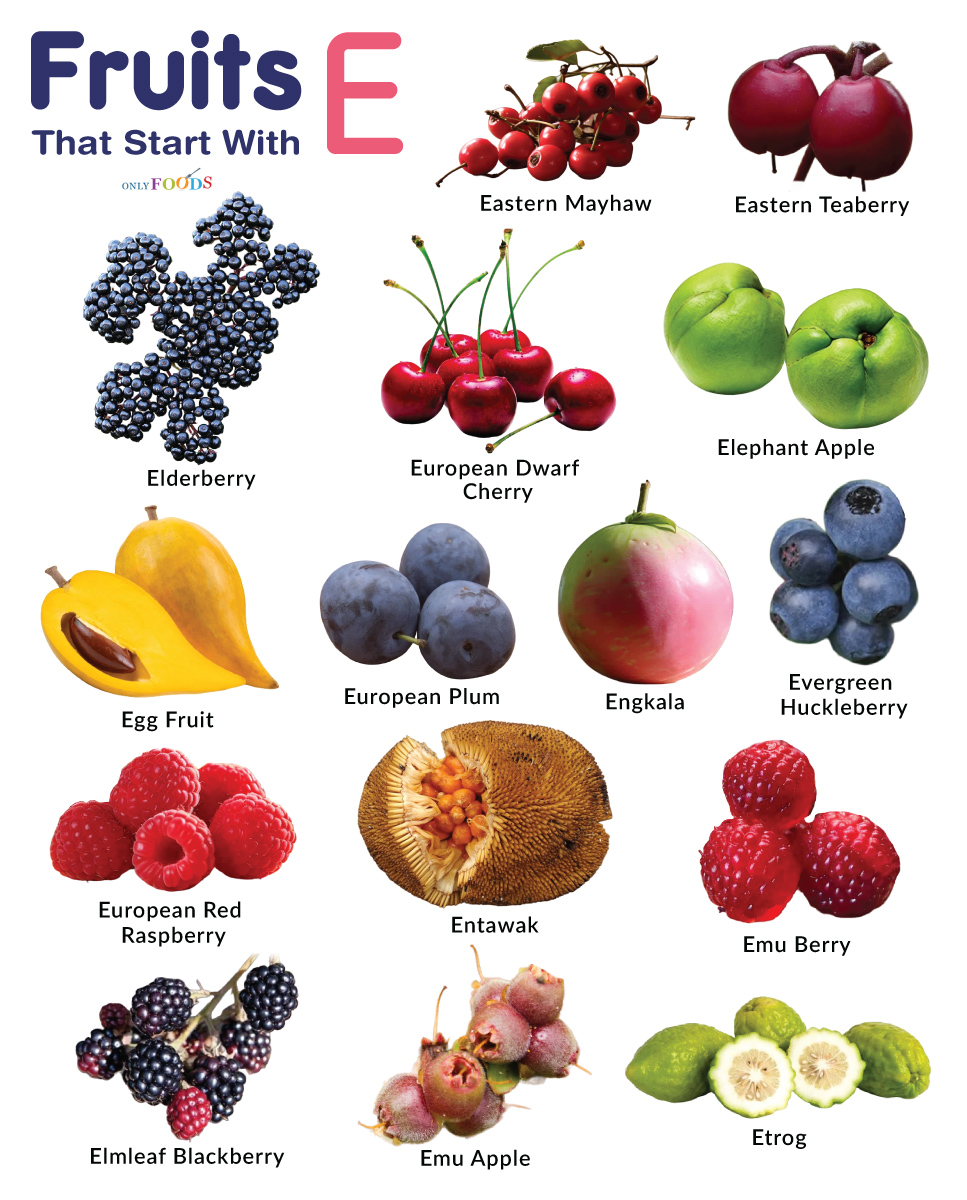Ever wondered what culinary treasures begin with the letter "E"? Prepare to be surprised, as the world of "E" fruits is far more diverse and delicious than you might imagine, spanning continents and offering a delightful array of flavors, textures, and nutritional benefits.
Embarking on a fruity expedition through the alphabet can unveil unexpected gems, and the "E" section is no exception. While the list may not be as extensive as some other letters, the fruits that do begin with "E" are nothing short of fascinating. From the familiar to the exotic, each fruit brings its unique character to the table, offering a taste of different cultures and culinary traditions. This exploration is a journey into the heart of the fruit kingdom, where every bite tells a story.
Before we dive into the vibrant world of "E" fruits, let's take a moment to appreciate the broader context. Fruits are, of course, a cornerstone of a balanced diet. Packed with vitamins, minerals, antioxidants, and fiber, they are nature's own pharmacy, contributing to overall health and well-being. The sheer variety of fruits worldwide is a testament to nature's creativity and the adaptability of plants to different climates and environments. From the juicy sweetness of a mango to the tartness of a cranberry, each fruit offers a unique sensory experience.
- Explore Mkvcinemas Free Movies Tv Shows Downloading What You Need To Know
- Anime In Hindi Vegamovies Watch Download Your Guide
Here's a comprehensive look at some of the remarkable fruits that start with "E":
1. Elderberry: A small, dark purple berry with a tart flavor. Elderberries are often used in jams, jellies, syrups, and wines. They are also known for their potential health benefits, particularly in supporting the immune system. They are native to Europe and North America.
2. Emu Apple: Native to Australia, this fruit has a tart, apple-like flavor. It is often used in jams, chutneys, and sauces. It is gaining popularity for its unique taste and nutritional value.
3. Early Gold Mango: Developed in Florida, this mango variety is known for its sweet, creamy flesh. It is a popular choice for fresh eating and is often used in smoothies, desserts, and other culinary creations. It was developed in the 1940s in Florida to extend the mango growing season.
4. Egg Fruit: Also known as Canistel, this fruit has a custard-like texture and a sweet, slightly savory flavor. It is often eaten fresh or used in desserts. Its vibrant yellow color makes it visually appealing.
5. Elephant Apple: Known by several names, including ou tenga, this fruit is characterized by its acidic, juicy flesh. It is a popular ingredient in chutneys, pickles, and other savory dishes. It is often found in tropical Asian countries.
6. Entawak: A tropical fruit with a unique flavor profile. It is often consumed fresh or used in various culinary applications.
7. Etrog: A citrus fruit similar to a citron, known for its thick, bumpy rind. It is used in Jewish religious ceremonies and has a unique, tart flavor that can be used in marmalades and other preserves.
8. European Pear: A widely cultivated fruit with a sweet, juicy taste. European pears come in various varieties, offering diverse textures and flavors. They are enjoyed fresh, cooked, and preserved.
9. Escarlate Grape: A type of grape known for its vibrant color and sweet taste. These grapes are a delicious snack and are also used in wines, juices, and other culinary creations.
10. Eugenia: Refers to a genus of flowering plants, including some species that produce edible fruits.
11. Emerald Grape: A green grape known for its sweet flavor. They are a refreshing treat and are used in a variety of recipes.
12. Evergreen Huckleberry: While a huckleberry is generally considered a berry and might be debated as a fruit, its culinary uses and nutritional profile make it worthy of mention. It offers a tart flavor and is often used in jams and pies.
13. Eggplant (Technically a Fruit): Though often used as a vegetable in savory dishes, eggplant is botanically a fruit. It is versatile in cooking, with a mild flavor that absorbs other flavors well.
14. Empetrum nigrum: Also known as black crowberry. Used in jams, jellies, and for medicinal purposes.
The culinary uses of "E" fruits are as diverse as the fruits themselves. From the simple pleasure of eating a fresh European pear to the complex flavors of an elephant apple chutney, these fruits offer a world of culinary possibilities. They can be incorporated into both sweet and savory dishes, adding unique textures and flavors. The variety of "E" fruits also means there is plenty of opportunity to discover new favorites and experiment with new recipes.
The nutritional benefits are an essential part of the appeal of "E" fruits. Many of these fruits are packed with vitamins, minerals, and antioxidants, contributing to overall health and well-being. The inclusion of these fruits in a balanced diet can aid in boosting the immune system, improving digestion, and providing essential nutrients.
Exploring fruits that begin with "E" is not just about expanding your culinary horizons; it is also a chance to learn new vocabulary and discover the origins of some of your favorite foods. Each fruit has its story to tell, from the tropical regions where they grow to the culinary traditions they are a part of. It is a journey that blends education with pleasure, offering a deeper appreciation of the world of fruits.
The "E" fruits showcase how the world of produce offers something for everyone. These fruits contribute to the variety and health benefits of a balanced diet. By exploring the world of "E" fruits, you'll be able to expand your culinary knowledge and introduce new flavors to your diet. So, get ready to taste your way through this delightful list.
Here's a more detailed look into some of these fruits:
Early Gold Mango:
This mango variety, cultivated to extend the growing season, is a true testament to agricultural ingenuity. Its origins lie in Florida, where it was developed to meet the growing demand for this tropical delight. The sweetness and creaminess of its flesh have made it a favorite for fresh eating, smoothies, and various desserts.
Elephant Apple:
Originating in tropical Asian countries, including China and India, the Elephant Apple presents a unique culinary opportunity. Its acidic, juicy flesh is the foundation for many chutney and pickle recipes, adding a distinctive flavor profile to these dishes. The Elephant Apple showcases the diverse ways in which fruits are used in cooking across different cultures.
Etrog:
With its thick, bumpy rind, the Etrog stands out among citrus fruits. Beyond its use in Jewish religious ceremonies, it offers a unique, tart flavor, which is perfect for marmalades and other preserves. The Etrog reminds us that fruits are not only part of our diet but also play a crucial role in our cultural and religious traditions.
European Pear:
A familiar face in the fruit world, the European Pear provides sweet, juicy goodness. Its versatility allows it to be enjoyed fresh, cooked, and preserved, making it a beloved staple in numerous cuisines. The European Pear embodies the delicious simplicity of fruits.
Escarlate Grape:
This grape variety, with its vibrant color, is a visual and gustatory delight. Its sweet taste makes it a perfect snack and a key ingredient in wines, juices, and other culinary creations. The Escarlate Grape shows how a single fruit can bring joy to the palate in numerous ways.
The fruits that start with "E" offer a compelling case for adventure. From the familiar sweetness of a pear to the exotic tang of an elephant apple, each one brings its flavor to the table. Incorporating these fruits into your diet means embracing culinary diversity, expanding your nutritional intake, and discovering new, tasty ways to enjoy a healthy, balanced life.
The "E" Fruits in Detail: Flavor, Origins, and Uses
Let's delve deeper into the world of "E" fruits, exploring their unique attributes and culinary applications. Here is a look at some of the fruits along with information about their origins, flavor profiles, textures, and culinary uses. This will help to understand what each fruit brings to the table.
Elderberry:
- Flavor: Tart, slightly bitter.
- Texture: Small, juicy berries.
- Origin: Europe and North America.
- Culinary Uses: Jams, jellies, syrups, wines, and sometimes in pies and other baked goods.
- Health Benefits: Known for potential immune-boosting properties.
Emu Apple:
- Flavor: Tart, similar to an apple.
- Texture: Firm, similar to an apple.
- Origin: Australia.
- Culinary Uses: Jams, chutneys, sauces, and sometimes as a flavoring in desserts.
- Unique Aspect: Offers a taste of Australian native cuisine.
Early Gold Mango:
- Flavor: Sweet, creamy.
- Texture: Soft, fleshy.
- Origin: Florida, USA.
- Culinary Uses: Fresh eating, smoothies, desserts, and various culinary creations.
- Unique Aspect: Developed to extend the mango season.
Egg Fruit (Canistel):
- Flavor: Sweet, slightly savory, custard-like.
- Texture: Creamy, custard-like.
- Origin: Tropical America.
- Culinary Uses: Eaten fresh, used in desserts, sometimes made into ice cream.
- Unique Aspect: Offers a unique texture and flavor combination.
Elephant Apple (Ou Tenga):
- Flavor: Acidic, juicy.
- Texture: Juicy flesh.
- Origin: Tropical Asia.
- Culinary Uses: Chutneys, pickles, and other savory dishes.
- Unique Aspect: Often used in Indian and Asian cuisine for its tangy flavor.
Entawak:
- Flavor: Unique flavor profile.
- Texture: Varies depending on ripeness.
- Origin: Tropical regions
- Culinary Uses: Eaten fresh, used in various culinary applications, like stews and curries.
- Unique Aspect: A tropical fruit with a distinct taste and versatility in cooking.
Etrog:
- Flavor: Tart, citrusy.
- Texture: Thick, bumpy rind.
- Origin: Mediterranean.
- Culinary Uses: Marmalade, preserves, and sometimes in liqueurs and candied form.
- Religious Significance: Used in Jewish religious ceremonies.
European Pear:
- Flavor: Sweet, juicy.
- Texture: Varies depending on the variety, from crisp to soft.
- Origin: Europe.
- Culinary Uses: Fresh eating, cooked, preserved, used in tarts, jams, and compotes.
- Popularity: One of the most widely consumed fruits.
Escarlate Grape:
- Flavor: Sweet.
- Texture: Juicy, crisp.
- Origin: United States (California).
- Culinary Uses: Fresh eating, wines, juices, and desserts.
- Visual Appeal: Known for its vibrant color.
This exploration of "E" fruits highlights the delicious variety within the fruit kingdom. Each fruit contributes its unique characteristics to the world of food and nutrition. The fruits starting with E are valuable additions to a balanced diet, as well as fascinating additions to one's culinary and cultural knowledge.
Remember, whether you are a seasoned food enthusiast, a curious learner, or simply someone who enjoys healthy and diverse eating, these fruits have something to offer. They are a great starting point for a tasty adventure through the alphabet of fruits.
- Exploring Somali Wasmo Telegram A 2025 Guide Community Insights
- Telugu Movies 2024 Watch Download Movierulz More


